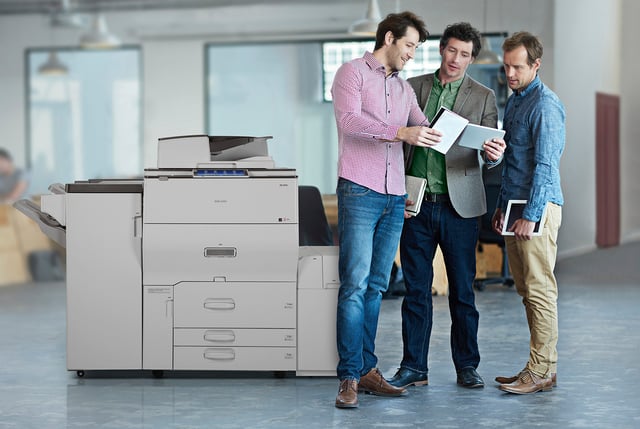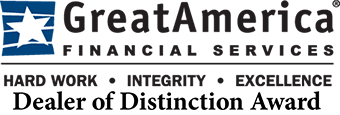
There are seven main buying criteria to consider when evaluating office equipment and an office equipment partner.
I believe that it is the partner that makes the equipment and not the other way around. I would take the best office equipment provider and pretty much any manufacturer that they sold, over an average of below average office equipment provider and the “year’s best” manufacturer or product.
That said the seven main categories are as follows: Reliability, Productivity, Versatility, Speed, Company, Service, and Price. Yes, I put price at the end because “price” typically only refers to the acquisition cost (whether lease or purchase) and the cost to service (cost per page), all of which is just part of the overall Total Cost of Ownership.
- The quality of the manufacturer, that specific model, and the servicing company of the system all factor into how reliable the system will perform. For the sake of this conversation I am only going to address the system itself and how it is built. It is my experience that there is usually a direct correlation between the actual price of the system (purchase price) and its quality and reliability. Some manufacturers build slightly better, or more robust units, than others. This isn’t true 100% of the time. For that matter, every manufacturer has models that, for whatever reason, don’t perform as well as their norm. But some easy things to evaluate between competing models would by the amount of plastic versus metal, the tightness (or flimsiness) of the paper drawers along with the document feed and finisher (if applicable). What is the PM (Preventive Maintenance Cycle)? The longer the better in most cases. Check the Drum and Supply yields, again the longer the better in most cases. And, of course, you can check online for ratings and reviews.
- Productivity is not the same as speed. Most manufacturers make their copiers in family units. For example, a 25 page per minute, 35 page per minute, and 45 page per minute may all be the exact same system just operating at different speeds. They will have the same parts, supplies, PM cycles, yields, etc. More importantly, they typically will have similar warm-up times, First Copy Out times, Single Pass Duplex, and other operating speeds outside of the actual pages per minute. So, with short runs (1-5 copies) the difference in productivity between a 25 page per minute and a 45 page per minute may be miniscule. Sometimes it can make a lot of sense to get a the slightly slower unit and save on the acquisition cost than it does to get the extra couple pages per minute.
- This is a very important category. With today’s technology there are so many things to consider when it comes to office equipment. It used to be simple. Do you want zoom? Would you like a 10-bin sorter or do you need the larger 20 bin? Now you need to consider if you need black and white only, or if you need color. If you need color, do you need business color, or do you need professional color. Do you need pantone matching, and/or a third-party driver? How many paper sources will you require? What size, weight and type of paper will you be using? Do you want it to copy, print and scan? Do you need user codes? Do you want to install Paper Cut or a similar Print Management Software? What are your finishing needs? Do you need booklet, folding, 3-hole punch, or maybe GBC binding?
With so many options available, it is always important to make sure that you know all the needs of your staff or department so that the system you acquire is versatile enough to meet those needs. Like anything, the more options you add, the higher the price.
- The majority of time, speed is over-rated. In most normal office situations, copies and/or prints are not large quantities where the system is running for 30 or more minutes at a time. It’s usually an end-user coming up to the machine and either copying 1-5 documents or picking up prints of 1-5 documents. That said, there are occasions where speed matters. If you are running large print or copy jobs, you don’t want to wait on a system that can only do 20 pages per minute. In addition, speed is typically directly tied to the monthly volume capability. The typical industry rule is that if a system is rated at 40,000 pages per month, you really only want to put it in an environment that is operating at 20,000 pages per month. The rating is more like the red line on a car’s tachometer than it is a recommendation.
The thing to remember here is that more speed equates to more money, so a commonsense balance of what is needed, versus what is wanted can save you a little bit of money.
- This refers to the company you are partnering with who will be your office equipment and technology partner. I have an entire other article dedicated to this one category, which I highly recommend you read if you haven’t.
To me this is the absolute most important piece when evaluating new office equipment, assuming the preferred company has the product to adequately meet your needs, and with rare exceptions this should be the case. So, what do you want out of your office equipment/technology partner?
The key aspects that I would look for are simple. You want a partner who is dedicated to their industry and an expert in their field. They should be members of industry groups, maybe sit on various vendor “Dealer Councils”, and so forth. One that is locally (regionally) owned and operated and that has not only a great local reputation, but also a good reputation within the industry by their industry peers and vendors. The longevity of the company is also important. Not just how long have they been in business but the average tenure of their employees as well. In addition to longevity, their overall success. If the company hasn’t grown in the last 5-10 years, or worse, is shrinking, that would concern me. On that note, I wouldn’t recommend a company too small (under $5 Million Gross Annually) because being that size makes it hard to compete and be effective in this industry. On the flip side, I would be careful of the overly large companies as their “corporate” structure may make them less flexible and less responsive. And finally, recognition. The most successful companies in our industry will have no shortage of awards and accolades, especially if they are growing. While many of these awards and especially certifications are important, I would also urge you to consider non-industry recognition. Chamber awards, community awards, community involvement and customer reviews.
- Make no mistake, the Office Equipment and Technology Industry is a service industry first and foremost. All of our equipment is service intensive and requires both Preventive and Responsive maintenance. There are multiple Key Performance Indicators that Office Equipment providers should be monitoring and sharing with you, the customer, so that you can continually be aware of how you are being serviced. Quick response times isn’t enough. You want a high First Call Efficiency (FCE) with little or no incomplete calls or call backs. You want factory trained and certified technicians that have the experience and the parts necessary to provide you with an FCE above 80% and ultimately with equipment uptime averaging more than 95%. You can read more about this HERE.
- It goes without saying that you don’t want to be overcharged or taken advantage of, but if you are looking for the lowest possible price, or the lowest possible price-per-page, or both, then you probably are not a good potential fit for any of the leading Office Equipment Providers. You can’t expect a company that invests the time, energy, and resources to become an industry leader to then also be the same price (or less) than another company who didn’t invest. Nor can you expect a low-cost provider to be capable of providing the same resources and benefits as an industry leader. It just doesn’t work. I am not in any way suggesting that you should over-pay. A low-cost provider shouldn’t be any more than 10% to 20% less than an industry top provider (a much smaller difference than Starbucks coffee vs. McDonalds coffee). Typically speaking that 10% to 20% is well worth the ancillary benefits you will receive from partnering with a true business expert and partner. If there is a huge price difference, it may have more to due with low-cost provider than it does with the high-quality company trying to take advantage, or it may not. But it’s been my experience that the top companies in the industry are far more interested in cultivating long term relationships with their customers than they are in taking advantage of a quick profit opportunity. Since copier prices can range from hundreds of dollars to more than a hundred thousand dollars, it’s all but impossible for me to say what a fair price would be, but I would estimate that 35%-55% off retail is normally very fair and reasonable. As an old friend of mine used to say. The bitterness of poor quality remains, long after the sweetness of low price is forgotten.
These are the seven buying categories, or criteria, as I have come to know them. It is each individual customer’s preference as to which categories they value most and which categories they value least. I hope that you found some of the information here within valuable and will ultimately be useful to you.
If you would like to download our Office Equipment Buying Checklist, PLEASE CLICK HERE.

